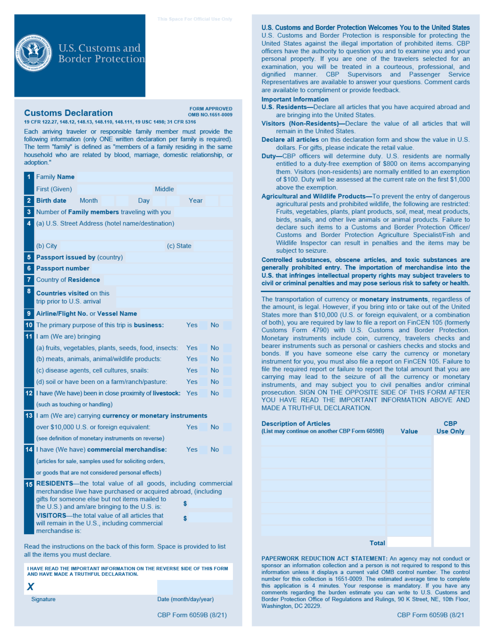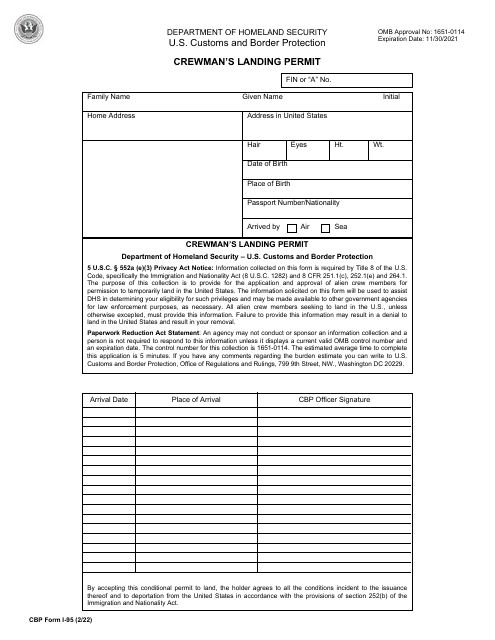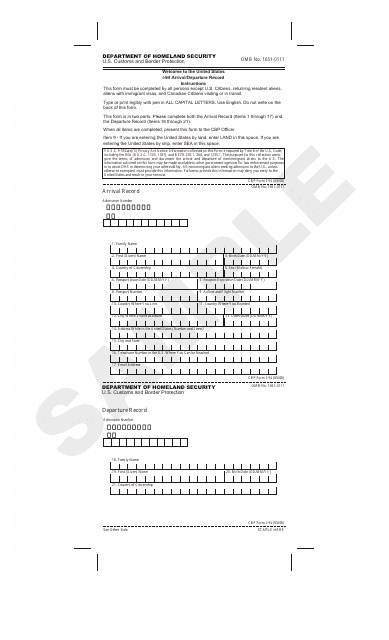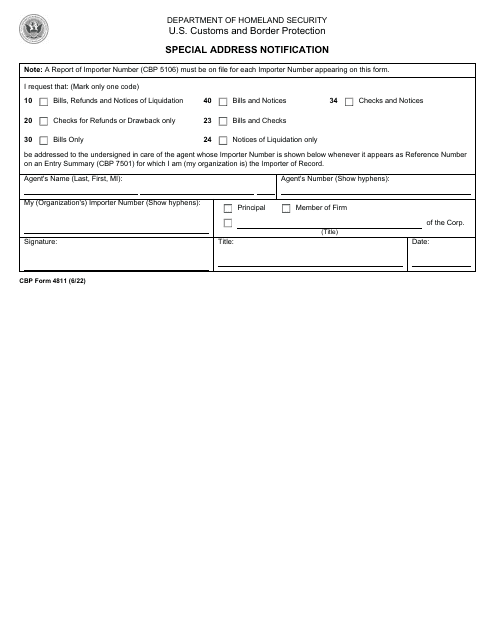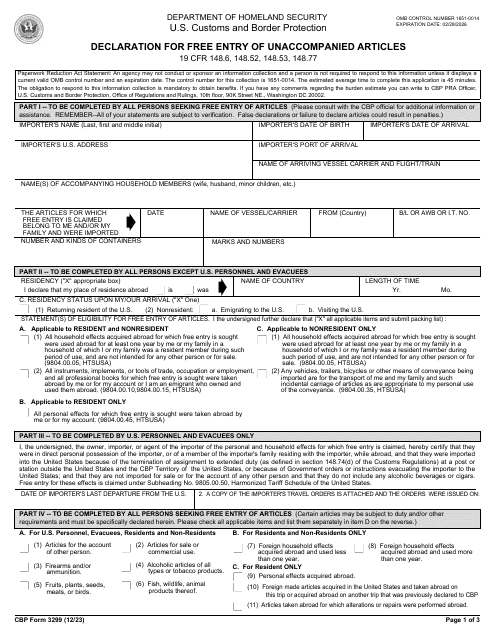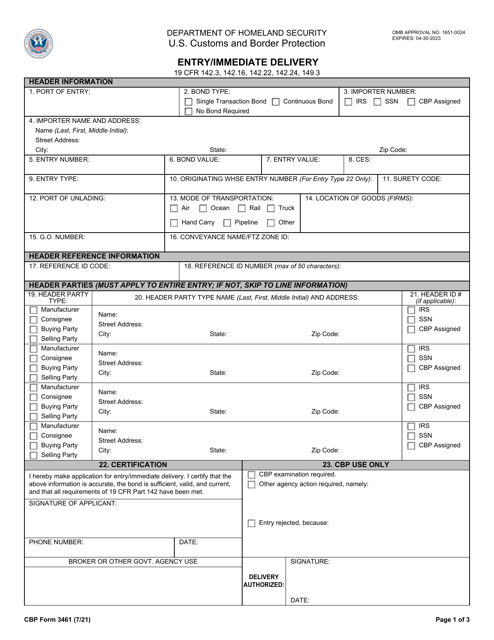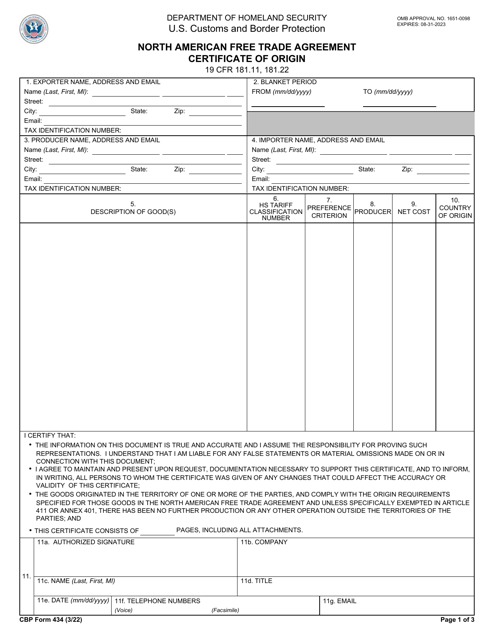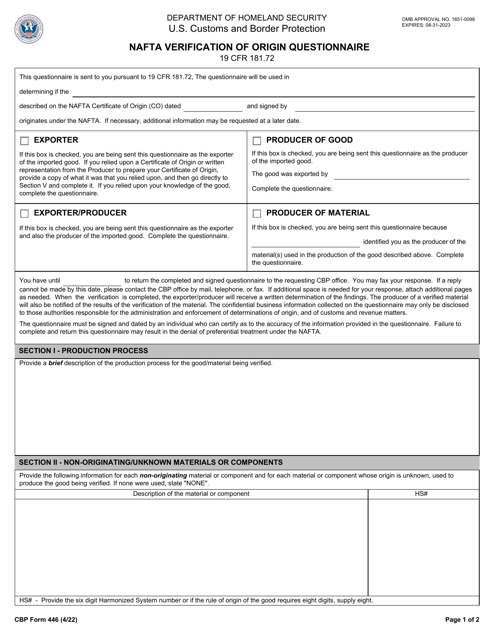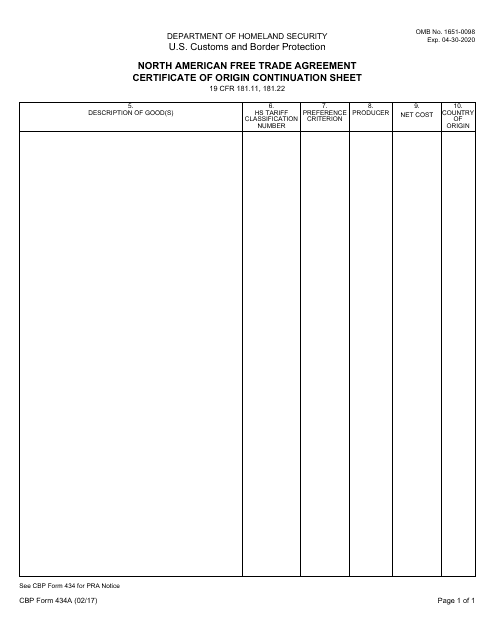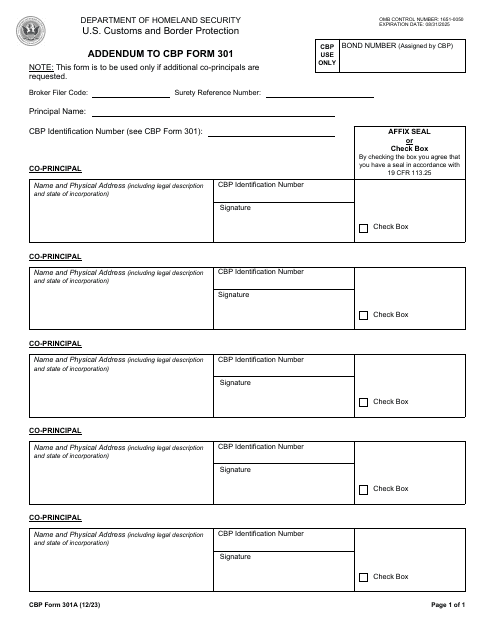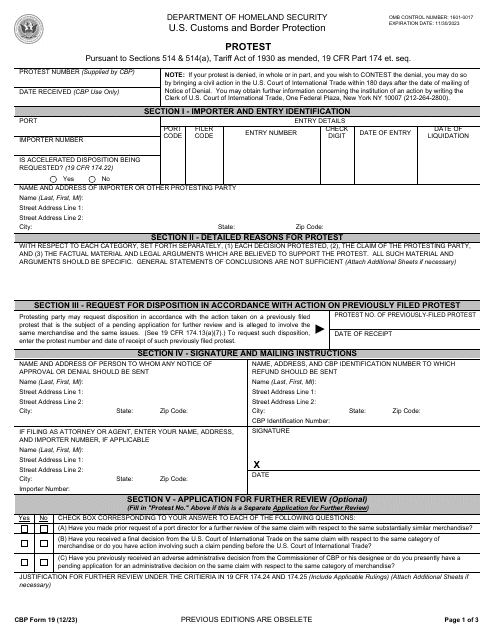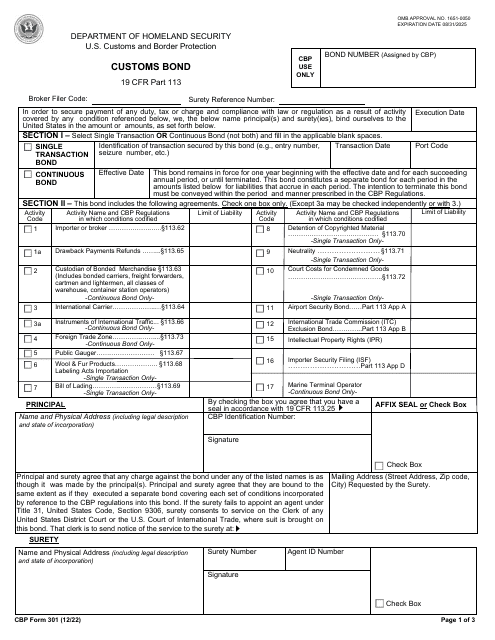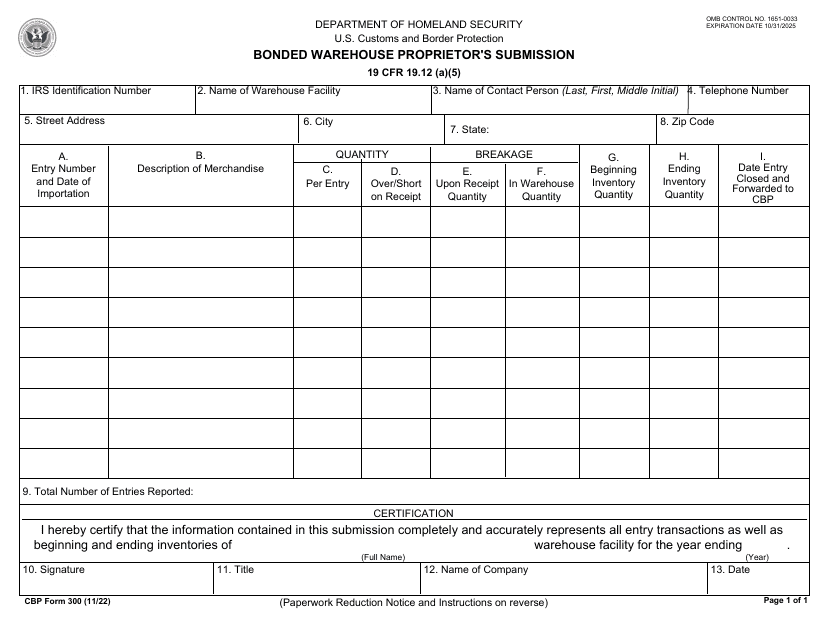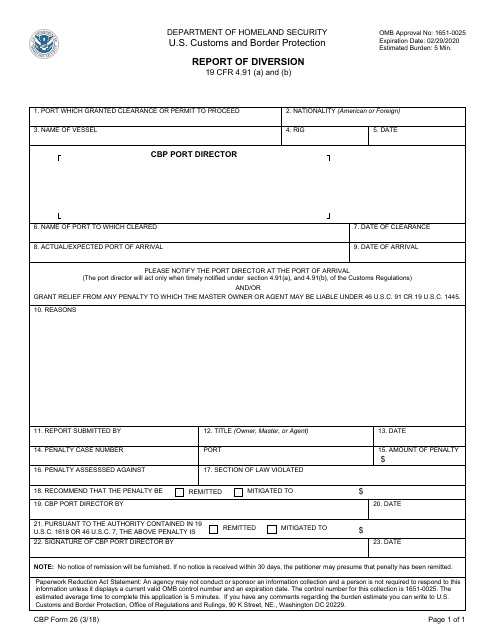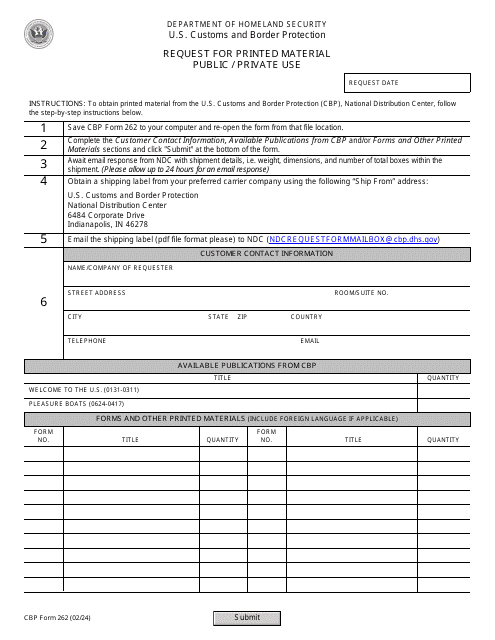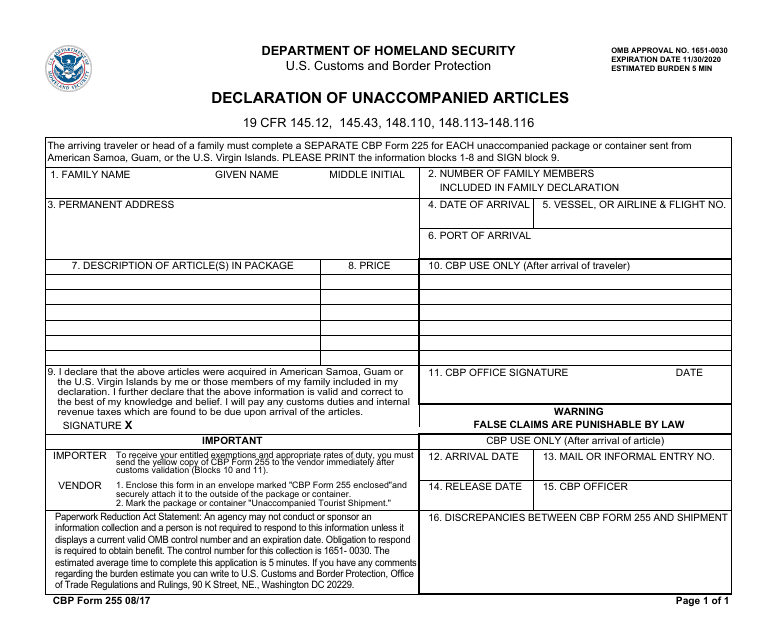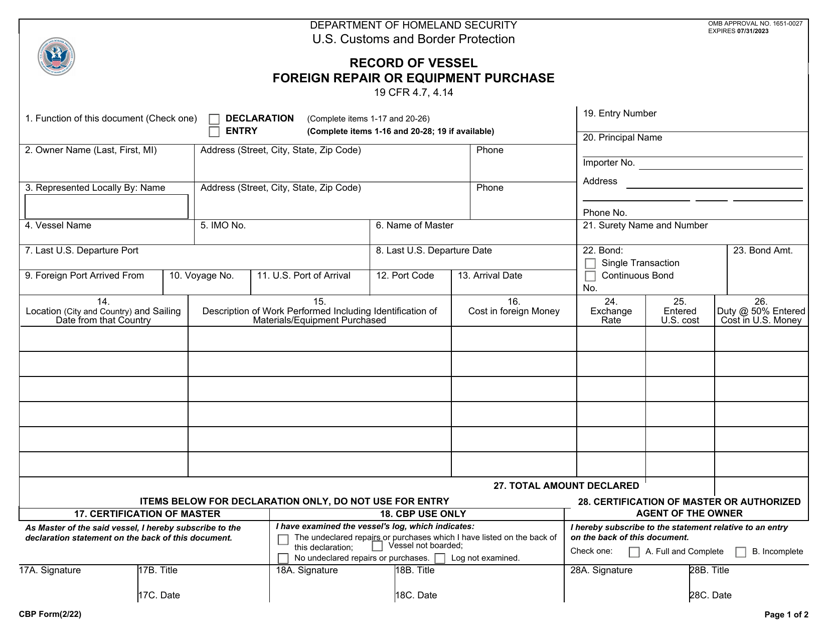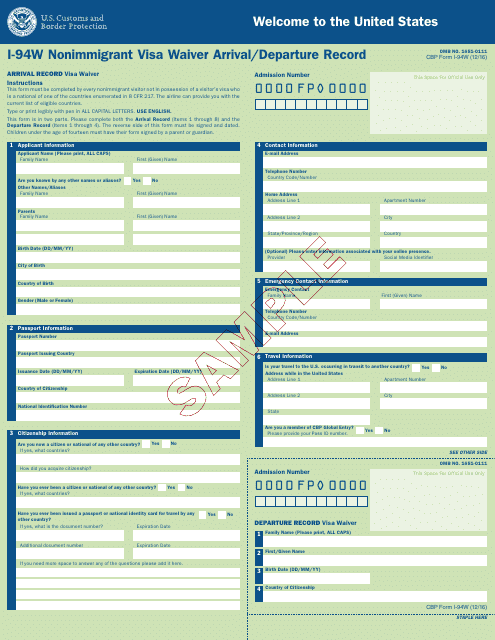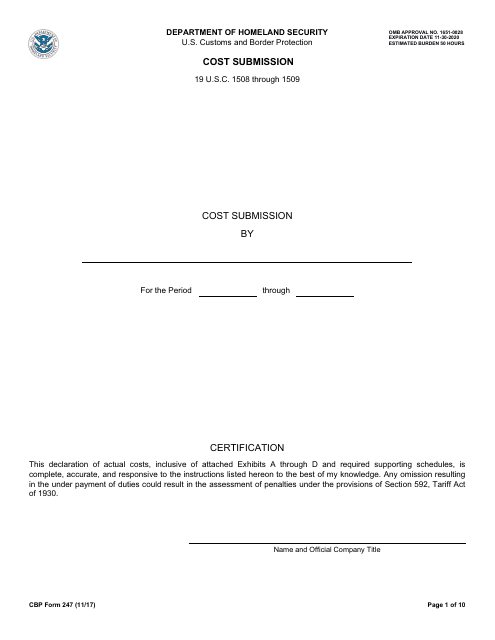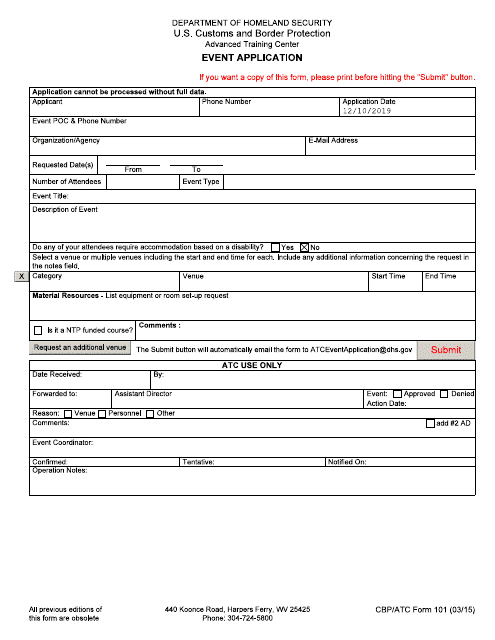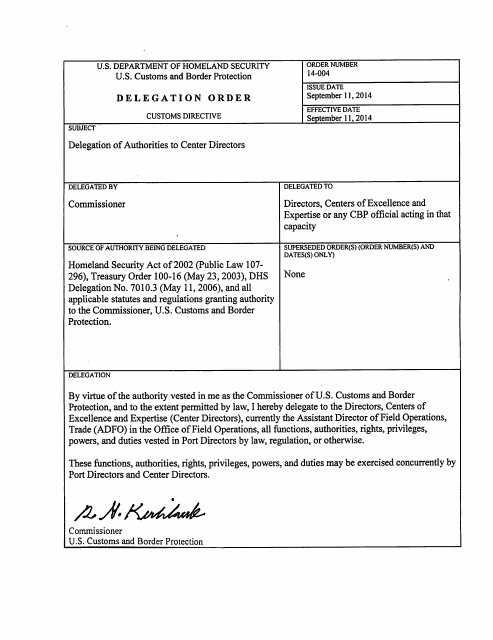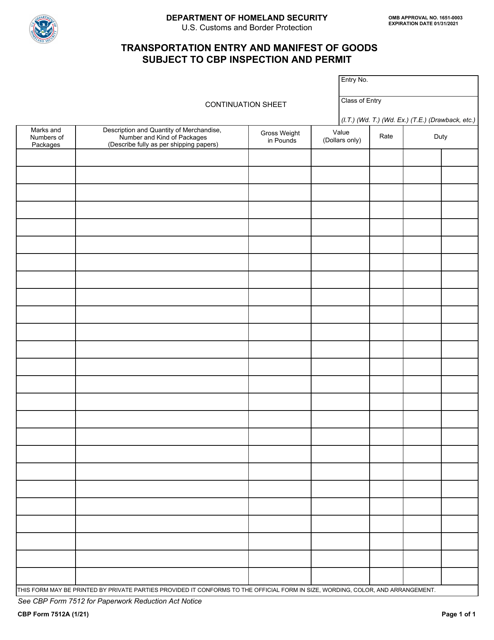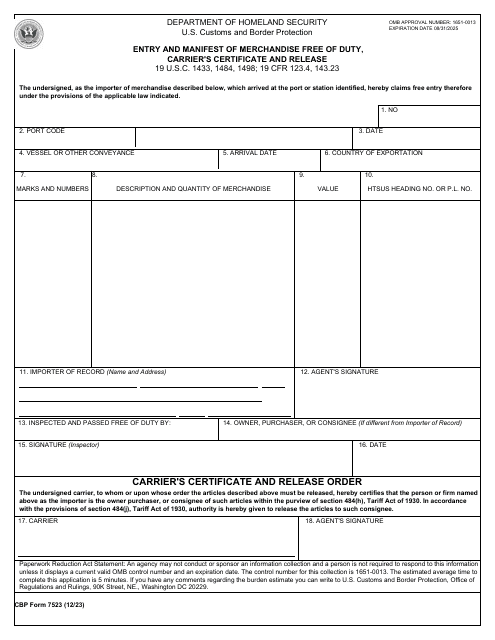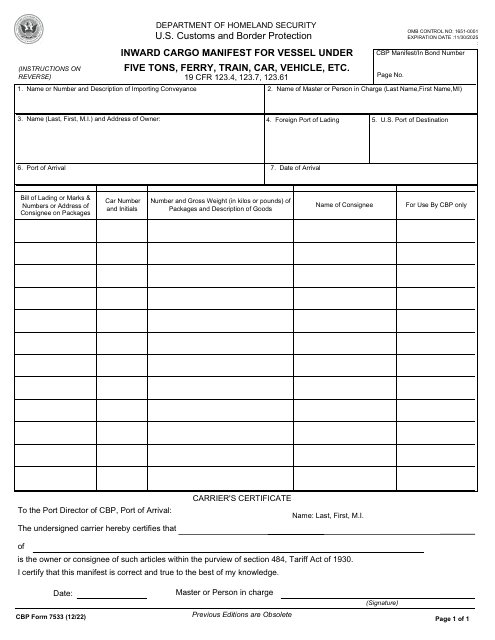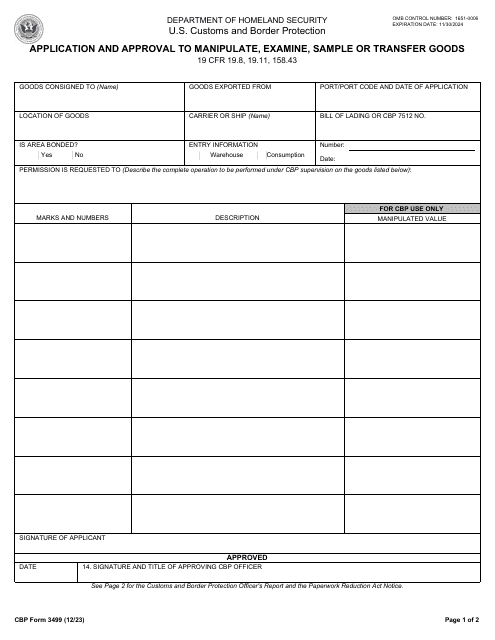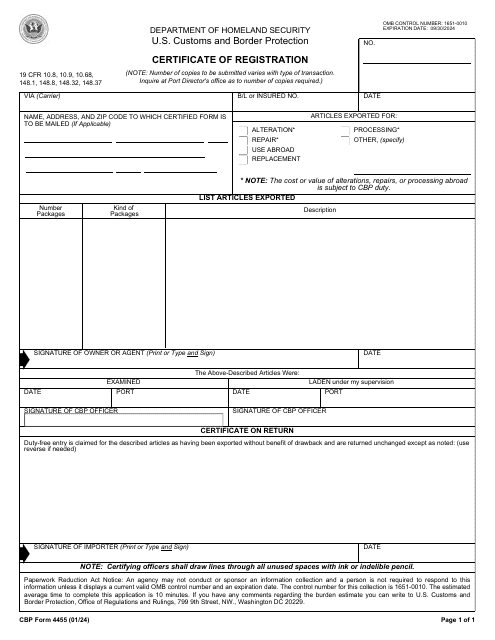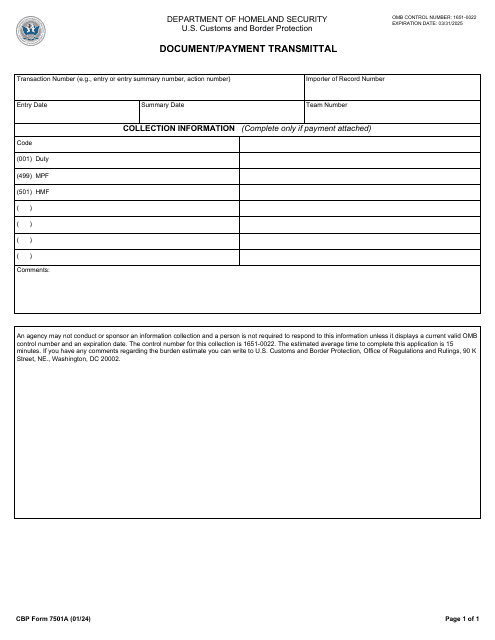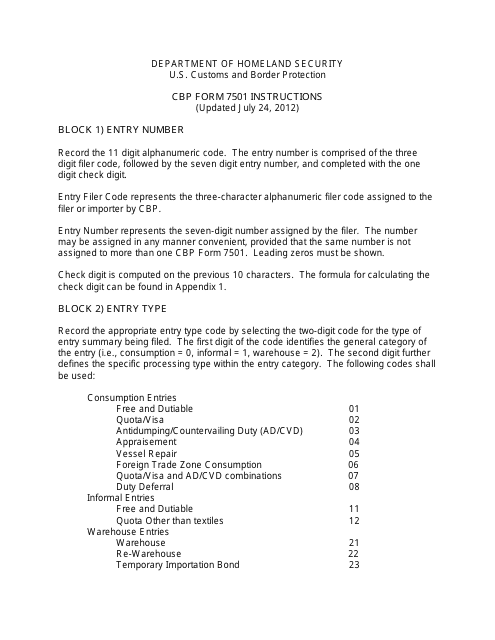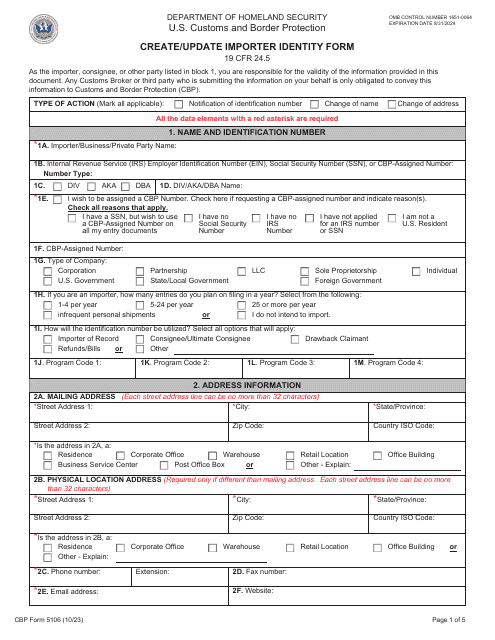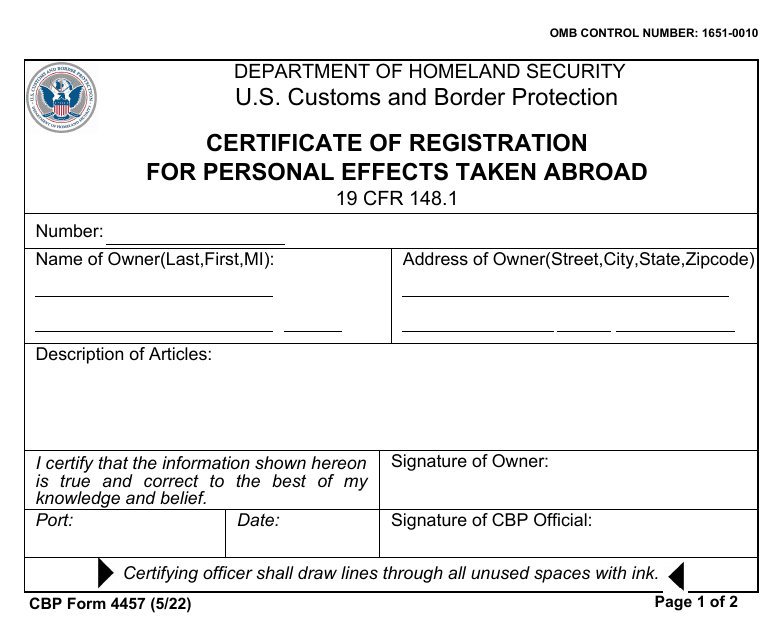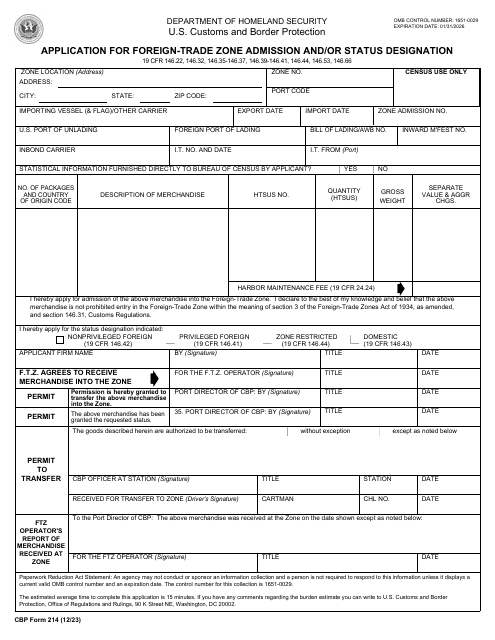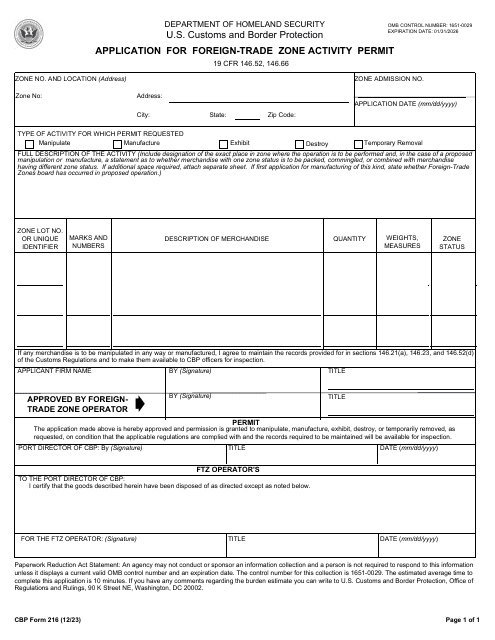Fill and Sign Customs and Border Protection (CBP) Forms
The U.S. Customs and Border Protection (CBP) protects the borders of the country. If you ever left the U.S. or came back, you must have dealt with multiple documents you have been asked to prepare - confirm your identity, inform the CBP officers about items, packages, and merchandise you bring with you abroad or to the U.S. territory, and pay taxes and duties required by federal laws.
The Customs and Border Protection Forms in our guide will improve your customs experience and safeguard your property and merchandise. Check out the links below for a full list of the latest fillable CBP Forms and instructions.
Popular U.S. Customs and Border Protection (CBP) Forms
The documents you find here are widely used by travelers who want to avert troubles when going abroad and coming back to the country and organizations that manage the import and export of goods. Learn how to reduce the amount of time at the border control and safely move the merchandise or your personal belongings to the foreign country of your choice or back to the U.S.
- CBP Form 301, Customs Bond. If you import goods that may be regulated by particular laws - for example, guns or food, you may need to comply with a surety bond requirement - the CBP must confirm you have paid all taxes, fees, and duties on time, otherwise, the surety bonds company pays them instead of you and you will need to compensate their expenses;
- CBP Form 434, North American Free Trade Agreement Certificate of Origin. Filled out by American, Canadian, and Mexican manufacturers and distributors, this CBP form confirms the exported goods are produced or obtained within the territory of either the U.S., Canada, and Mexico so that they can be processed under a lower tariff;
- CBP Form 3299, Declaration of Free Entry of Unaccompanied Articles, is used by individuals who enter the territory of customs to describe the imported or exported goods. The shipment must be examined by the CBP at the first port of arrival, so prepare a list of items in advance to prevent the delay;
- CBP Form 3499, Application and Approval to Manipulate, Examine, Sample, or Transfer Goods, is filed by transferees and consignees of merchandise who plan to check and observe the goods at the CBP-approved facility. You need to describe the items that will be manipulated and name the people who will perform the operation;
- CBP Form 3461, Entry/Immediate Delivery, is an electronic form filed to the CBP - they will check the information in the document and, if confirmed correct, the imported goods' release will be sped up or the merchandise will be sent for examination. Once the goods are released, you need to provide the CBP with a proper description of all items;
- CBP Form 4455, Certificate of Registration. If you are traveling with items made abroad, you need to certify they have been in your possession before you departed the U.S. - register your property before leaving, and the CBP will compare the details listed in the statement with your items so that you avoid issues when re-entering the country;
- CBP Form 4457, Certificate of Registration for Personal Effects Taken Abroad. Often used for electronic devices that have distinguishing characteristics such as serial numbers or markings, for instance, computers and watches, this statement allows travelers to register their personal belongings before they go to a foreign country - these items will be easily cleared when you bring them back on your return;
- CBP Form 5106, Create/Update Importer Identity Form. All importers must be registered with the CBP and assigned a specific number so state your name and contact information, describe your company, and identify its main officers. Additionally, you can update the details in this document to provide the CBP with relevant information about your business;
- CBP Form 6059B, Customs Declaration. Prepared by all foreign visitors and American citizens who arrive in the country after being abroad, this form identifies all people who enter the territory of the U.S., records whether any wildlife and agricultural products are being imported, and documents the amount of money residents and visitors carry while at customs;
- CBP Form 7501, Entry Summary, is completed by individuals and companies to describe the merchandise that is being imported and will later be included in the American commerce and to record the amount of internal revenue tax and duty paid. You must submit this document within ten days from the time the goods arrive in the country;
- CBP Form 7512, Transportation Entry and Manifest of Goods Subject to CBP Inspection and Permit. If your shipment was not cleared by the CBP and you import or export merchandise in bond, identify the packages in line with their shipping documentation and state the country of export and the destination of the goods;
- CBP Form 7523, Entry and Manifest of Merchandise Free of Duty, Carrier's Certificate and Release, lets goods that cost no more than $2,500 go freely through the border control without additional payments, including taxes. Present the original statement to the CBP officer once the items arrive at the customs;
- CBP Form 7533, Inward Cargo Manifest for Vessel Under Five Tons, Ferry, Train, Car, Vehicle, etc. This form is prepared for all vehicles that do not outweigh five tons - it lists basic characteristics of the item, indicates where the shipment was prepared and where it is supposed to be delivered, and identifies the person responsible for it.
Browse CBP Forms by Category
Most forms developed by the U.S. Customs and Border Protection can be completed online, saved, and printed. Browse the categories below to download the latest versions of CBP Forms to file online or through a PDF-filing application of your choice.
Travel-Related CBP Forms
- CBP Form 339A, Annual User Fee Decal Request - Aircraft;
- CBP Form 339C, Annual User Fee Decal Request - Vehicle Application;
- CBP Form 339V, Annual User Fee Decal Request - Vessel;
- CBP Form 4457, Certificate of Registration for Personal Effects Taken Abroad;
- CBP Form 7507, General Declaration Agriculture, Customs, Immigration and Public Health;
- CBP Form 823S, SENTRI Application;
- CBP Form I-68, Canadian Border Boat Landing Permit;
- CBP Form I-94, Arrival/Departure Record;
- CBP Form I-94W, Visa Waiver Arrival/Departure Record;
- CBP Form I-95, Crewman's Landing Permit;
- CBP Form I-408, Application to Pay Off or Discharge Alien Crewman;
- CBP Form I-418, Passenger List - Crew List;
- CBP Form I-736, Guam CNMI Visa Waiver Information;
- CBP Form I-775, Visa Waiver Carrier Agreement.
Travel Industry Personnel-Related CBP Forms
Trade-Related CBP Forms
- CBP Form 19, Protest;
- CBP Form 26, Report of Diversion;
- CBP Form 214, Application for Foreign-Trade Zone Admission and/or Status Designation;
- CBP Form 214A, Application for Foreign-Trade Zone Admission and/or Status Designation;
- CBP Form 214B, Application for Foreign-Trade Zone Admission and/or Status Designation Continuation Sheet;
- CBP Form 214C, Application for Foreign-Trade Zone Admission and/or Status Designation Continuation Sheet;
- CBP Form 216, Application for Foreign-Trade Zone Activity Permit;
- CBP Form 226, Record of Vessel Foreign Repair or Equipment Purchase;
- CBP Form 247, Cost Submission;
- CBP Form 255, Declaration of Unaccompanied Articles;
- CBP Form 300, Bonded Warehouse Proprietor's Submission;
- CBP Form 301, Customs Bond;
- CBP Form 301A, Addendum to CBP Form 301;
- CBP Form 400, ACH Debit Application;
- CBP Form 401, ACH Credit Enrollment;
- CBP Form 434, North American Free Trade Agreement (NAFTA) Certificate of Origin;
- CBP Form 446, NAFTA Verification of Origin Questionnaire;
- CBP Form 447, NAFTA Motor Vehicle Averaging Election;
- CBP Form 450, United States-Caribbean Basin Trade Partnership Act (CBTPA) Certificate of Origin;
- CBP Form 1243, Canine Center Event Application;
- CBP Form 1302, Inward Cargo Declaration;
- CBP Form 1302A, Cargo Declaration - Outward with Commercial Forms;
- CBP Form 1303, Ship's Stores Declarations;
- CBP Form 1304, Crew Effects Declarations;
- CBP Form 1401, Record of Vessels Engaged in Foreign Trade Cleared and Granted Permit to Proceed;
- CBP Form 3124, Application for Customs Broker License;
- CBP Form 3124E, Application for Customs Broker License Exam;
- CBP Form 3171, Application-Permit-Special-License-Unlading-Lading-Overtime Services;
- CBP Form 3173, Application for Extension of Bond for Temporary Importation;
- CBP Form 3227, Certificate of Disposition of Imported Merchandise;
- CBP Form 3229, Insular Possession Certificate of Origin;
- CBP Form 3299, Declaration of Free Entry of Unaccompanied Articles;
- CBP Form 3311, Declaration of Free Entry of Returned American Products;
- CBP Form 3347, Declaration of Owner for Merchandise Obtained in Pursuance of a Purchase or Agreement to Purchase;
- CBP Form 3348, Declaration of Consignee When Entry is Made by an Agent;
- CBP Form 3461, Entry/Immediate Delivery;
- CBP Form 3461C, Entry/Immediate Delivery Continuation;
- CBP Form 3461ALT, Entry/Immediate Delivery;
- CBP Form 3485, Lien Notice;
- CBP Form 3499, Application and Approval to Manipulate, Examine, Sample, or Transfer Goods;
- CBP Form 4455, Certificate of Registration;
- CBP Form 4457, Certificate of Registration for Personal Effects Taken Abroad;
- CBP Form 4609, Petition for Remission or Mitigation of Forfeitures and Penalties;
- CBP Form 4630, Petition for Relief from Forfeiture;
- CBP Form 4632, Lien Holder Financial Statement;
- CBP Form 4811, Special Address Notification;
- CBP Form 5106, Create/Update Importer Identity Form;
- CBP Form 5125, Application for Withdrawal of Bonded Stores for Fishing Vessel and Certificate of Use;
- CBP Form 5129, Crew Member's Declaration;
- CBP Form 5297, Corporate Surety Power of Attorney;
- CBP Form 6043, Delivery Ticket;
- CBP Form 6478, Application for CBP Approved Gaugers and Accredited Laboratories;
- CBP Form 7501, Entry Summary with Continuation Sheets;
- CBP Form 7501A, Document/Payment Transmittal;
- CBP Form 7507, General Declaration Agriculture, Customs, Immigration and Public Health;
- CBP Form 7509, Air Cargo Manifest;
- CBP Form 7512, Transportation Entry and Manifest of Goods Subject to CBP Inspection and Permit;
- CBP Form 7512A, Transportation Entry and Manifest of Goods Subject to CBP Inspection and Permit - Continuation Sheet;
- CBP Form 7523, Entry and Manifest of Merchandise Free of Duty, Carriers Certificate and Release;
- CBP Form 7533, Inward Cargo Manifest for Vessel Under Five Tons, Ferry, Train, Car, Vehicle, etc.;
- CBP Form 7553, Notice of Intent to Export, Destroy or Return Merchandise for Purposes of Drawback;
- CBP Form 823F, FAST Commercial Driver Application - Mexico;
- CBP Form 823S, SENTRI Application.
Automated Commercial Environment (ACE) Forms
Where to Mail CBP Forms?
The mailing address for each and every one of these forms depends on the type of form and its requestor. Look through the instructions on the form you've completed to the appropriate address. Use the official CBP website to find more information about applicable pforcedures and fees that are supposed to be paid before forms are submitted.
Not what you were looking for? Check out these related tags:
- Federal Legal Forms released by the departments of the United States Federal Government;
- United States Legal Forms by state;
- Other Legal Forms by country.
Documents:
372
The purpose of this form is to gather data about the arrivals and departures of aliens who have non-immigrant visas and enter the U.S.
You have to provide a detailed description of your unaccompanied articles, as only a complete inventory of imported goods will be accepted by the Customs and Border Protection (CBP).
Fill out this form when you import items into the United States. The Customs and Border Protection (CBP) uses this information to verify that the consignee and shipment details are correct, and a bond is in the CBP records.
This form is used by the United States, Canada, and Mexico and is a trilaterally agreed up form. It is used to certify that the goods qualify for the preferential tariff treatment determined by the North American Free Trade Agreement (NAFTA).
This is a supplementary form for CBP Form 434, which is completed by the exporter in case additional goods description is asked of them. To get by a North American Free Trade Agreement (NAFTA) preference, the importer must have a certificate of origin when the claim is made.
Use this Customs and Border Protection (CBP) form to provide information about additional co-principals. This document is part of the CBP Form 301 and cannot be filed separately.
This form is an agreement between a principal, obligee, and surety. Fill it out as a proof of payment of fees, taxes, and duties, and to make sure you comply with the law regarding goods and activities.
This Form is used for reporting any diversion of imported merchandise to unauthorized purposes.
This form is used for declaring unaccompanied articles when entering or leaving the United States.
This document is used for the Nonimmigrant Visa Waiver Arrival/Departure Record.
This form is used for submitting costs to the U.S. Customs and Border Protection (CBP).
This document is an application form for attending events at the CBP Advanced Training Center (ATC).
This document is a delegation order, number 14-004, which was effective on September 11, 2014. It specifies the delegation of certain duties or responsibilities to a designated individual or group.
Use this form if you are carrying goods to the United States in order to enlist all cargo items and provide detailed information about them for the Customs and Border Protection (CBP) and Department of Homeland Security.
This is a supplementary form to use if you are transporting goods to the United States. The form serves to provide additional information of the cargo to help the Customs and Border Protection (CBP) to identify it.
This form is required by the Customs and Border Protection (CBP) and is only used in certain situations by importers and carriers as a manifest for the entry of merchandise free of duty into the United States.
This form is used by the Customs and Border Protection (CBP) to describe the cargo baggage arriving in baggage cars, as well as for vehicles or vessels of less than 5 net tons arriving in the United States from Canada or Mexico with baggage or merchandise
File this application if you are an importer, transferees, consignee, or owner of the merchandise that you transport to the United States in order to perform various operations on your merchandise while at Customs and Border Protection (CBP) facilities.
Fill out this form prior to departure if you are a traveler and wish to provide supporting documentation for the temporary export of your gear and equipment. This will facilitate the return to the States with the items you are leaving the country.
This form serves to describe relevant information about the imported commodity, such as its origin, classification, and appraisement. The information is used to record the amount of tax and duty paid.
The Customs and Border Protection (CBP) uses this form to link a supplemental payment after an original automated clearing house payment with the associated entry. It verifies the respondent's account.
You need this form to fill out the CBP Form 7501 correctly.
Download this form to create or update an Importer Account with Customs and Border Protection (CBP). Anyone who submits their first entry has to file an import entry. This information is entered into the CBP's database or is used to correct the file of a registered importer.
Download this form to register your personal equipment when traveling anywhere outside the United States. It is required by the Customs and Border Protection (CBP) and facilitates your entry into the country with the same equipment.
Use this form when you import cargo into the United States. This document is part of the CBP Form 3461 and is filled out when you need additional space for indicating Line and Bill of Landing information.

